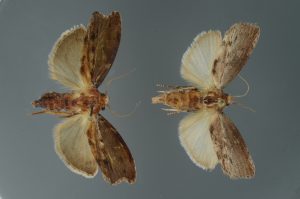Members of the UF/IFAS Honey Bee Research and Extension Laboratory conducted a research project that led to a publication on the use of essential oils for the control of greater wax moths in honey bee colonies. Below is a summary of that research as well as a link to the full publication.
Background: The greater wax moth (Galleria mellonella L.) is a secondary pest of honey bees found worldwide. While these pests generally only have minor impacts on otherwise strong colonies, they can infest and takeover small or relatively weak colonies and are particularly problematic and damaging for stored beekeeping equipment and drawn combs. There are currently no effective chemical controls for wax moths in living colonies and control options for these pests in stored equipment are limited and often unreliable. You can learn more about greater wax moths and their controls, here: Wax Moth Control

Purpose: The purpose of this study was to test the toxicity of eight compounds on greater wax moth adults and larvae. Carvacrol, carvone, citral, estragole, linalool, limonene, thymol, and γ-terpinene are all compounds found in essential oils, many of which have been shown previously to be effective in controlling other moth pests.
Key Findings: This study showed varying responses of greater wax moth larvae and adults to the test compounds:
- Thymol was found to be highly toxic to both adult and larval greater wax moths.
- Carvacrol and citral were also highly toxic to the larvae but were less toxic to the adults.
- Linalool showed some toxicity to both larvae and adults.
- Limonene, γ-terpinene, and estragole showed limited toxicity to larvae and adults.

Significance: Linalool, carvacrol, citral, and especially thymol show promise for future control products for greater wax moths. Previous research has shown these compounds to be relatively safe for honey bees within specific applications, although some negative effects on bees have been shown. Future research is needed on these four compounds to test their control efficacy on stored wax combs, to determine application requirements (e.g. how long should treated combs be ventilated before returning them to living colonies?), as well as their toxicity to bees within these contexts. Limonene, γ-terpinene, and estragole are unlikely to be effective controls of greater wax moths.
For more details, you can read the full publication here: https://doi.org/10.1093/jee/toaa249
This blog post was written by UF IFAS Honey Bee Lab’s Instructional Designer, Mary Bammer and revised by Amy Vu.
Sohail, M., Aqueel, M. A., Dai, P., Ellis, J. D. (2020). The larvicidal and adulticidal effects of selected plant essential oil constituents on greater wax moths. Journal of Economic Entomology 114(1), 397-402. https://doi.org/10.1093/jee/toaa249
 0
0
